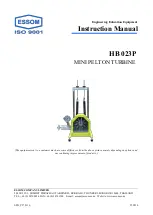
ESSOM COMPANY LIMITED
Section 2: Theory
7
Runner
Blade
Water jet
Cm
2
= W
2
C
2
U
2
= Cu
2
2
2
Figure 2- 8
:
Front view diagram
.
Rotation
Runner
Blade
Axis of rotation
α
Water jet
Figure 2- 9
:
Top view diagram
.
For the axial flow impulse turbine, a water jet is directed at an angle
α
to the blades at the peripheral of the runner
which is enclosed in a pipe or tube
.
The impact of the jet on the blades creates a force
F
which generates a turning moment
Fr
on the runner shaft
.
After passing through the runner blade, water velocity is reduced
.
Thus part of the jet kinetic energy is converted
to the turbine mechanical energy
.
2
.
3
.
2 Reaction type turbine
In this type, there is no transformation of a free jet in the turbine as comparing to the impulse
(
Pelton
)
turbine
.
In this
type of turbine, part of the pressure head is transformed into velocity head by guide vanes outside the runner that directs
water to flow into the runner
.
This over pressure causes an acceleration of the relative velocity of the water passing
through the runner
.
Water is then discharged from the runner in an axial direction to the open space at the atmospheric
pressure
.
The advantageous characteristics of this type make it suitable for hydroelectric power stations of medium to
large sizes, which can be operated efficiently at a range from medium to high pressure head, and at flow rates in the
medium range
.
Notable turbines under this type are Francis, Kaplan, and Axial
-
Flow Turbines
In all types of turbine, pressure head is transformed partially or wholly into velocity head
.
▪
Francis Turbine
The Francis turbine is a reaction type of turbine
.
In this type there is a housing fitted with guide vanes completely
surrounding the runner
.
The runner is a wheel provided with vane, and fluid enters it completely around the periphery
.
As
shown in
Error! Reference source not found.
, water under pressure flows into a spiral housing which goes completely
around the runner
.
After flowing through adjustable guide vanes, the water passes through the rotating runner in a plane
practically normal to the axis of rotation
.
The flow is largely radially inward and the machine is so frequently called a
radial
-
flow Francis turbine
.
Where
:
=
Blade velocity,
=
Absolute velocity,
C
u
=
Whirl velocity
(
relative component of C
)
,
C
m
=
Meridian velocity,
=
Relative velocity,
U
s
/
m
C
s
/
m
s
/
m
s
/
m
W
s
/
m



























